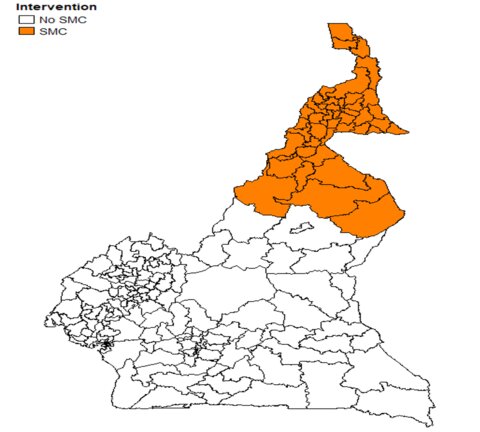SMC Coverage 2023

In 2023, Cameroon implemented SMC in 16 districts from June to October in children aged three months to five years. Coverage was about 96%. Four cycles of SMC were implemented in 33 districts and five cycles in 14 districts.
Since Cameroon’s 2014-2018 malaria strategic plan, SMC has been included among the country’s malaria prevention strategies. In 2016, SMC was introduced in areas with highly seasonal transmission of the disease (North; Far North).
SMC has been implemented in mass campaign mode with a significant mobilization of resources and logistics without strengthening the health system as a consequence. Key challenges that have been encountered include integration into existing programmes; sustainability of the intervention; and decrease in funding.
Given this, SMC in routine mode was piloted and compared with the mass campaign mode. Several findings have been made. These include the fact that implementing SMC in routine mode ($1.02 per child) is cheaper than in campaign mode ($1.24 per child). Community Health Workers have also been equipped with working materials for routine activities and hence there is no need for the purchase of materials. There has also generally been an improvement in the treatment and referral of fever cases in the community during SMC campaigns. What is more, there has been an improvement in the quality of data collection tools used for SMC. Consequently, there has been a clear decline in malaria-related morbidity and mortality since the introduction of the routine in 2022.
However, there is a need to better integrate SMC activities, such as better acceptance by the populations. Community volunteers should also be better known and accepted by their community, among others. Additional training is needed for community health workers to strengthen routine SMC and improve upon the target coverage. It would also be helpful to digitize the data collection process for the administration of SMC.
In comparing routine SMC administration versus mass campaign mode administration, routine SMC administration was considered to be a more innovative, effective, and efficient approach, and was well accepted by households. Routine SMC however does not differ greatly from the mass campaign in terms of programmatic results. Routine implementation of SMC however requires the presence of a well-established community system with adequate coverage of community health volunteers.
Areas eligible for SMC and areas where SMC is implemented in 2023

SMC Coverage Information 2023 and 2024
|
2023 |
2024 |
|
|
Start and end dates |
June - October |
- |
|
Number of cycles |
4 (33 DS); 5 (14 DS) |
- |
|
Number of districts targeted |
47 |
- |
|
Number of children covered |
2,135,823 |
- |
|
Age groups covered |
3 to 59 months |
3 to 59 months |
|
Coverage (% of targeted children receiving all cycles) |
96.1% |
- |
|
Have drug resistance tests or efficacy studies been carried out? (WE) |
No |
- |
|
gap |
- |
- |